CES 2015: Sensors Lead the Way in Mercedes-Benz Future Car
January 13, 2015

Automotive sensor technology is taking a giant stride forward in a futuristic luxury concept car that's part chauffeur, part lounge, and part entertainment theater.
At the Consumer Electronics Show (CES) last week, Mercedes-Benz showed off the new technologies in a head-turning concept vehicle called the F 015. Although aimed at the 2030 timeframe, the F 015 drew massive crowds at the show, thanks to a vehicle interior packed with consumer electronics technology and an exterior that virtually forced showgoers to stop in their tracks.
The underlying concept of the vehicle is one that puts passenger socialization ahead of old-fashioned driving. Endowed with autonomy, the F 015 permits occupants to sit in lounge chairs arranged in a face-to-face configuration, with the driver facing the rear, if desired.
Click on the F 015 to start the slideshow.

Autonomy is made possible by exterior sensors that look forward, back, and to the sides. In all, the vehicle uses six radar sensors -- long-range radar in front and back, combined with shorter-range sensors at each of the vehicles corners. A stereovision camera also examines the road head, measuring the distances to objects that might get in the way of the vehicle.
Unlike self-driving cars seen in DARPA's Grand Challenge races, the F 015 employs no rotating Lidar (light + radar) sensors on its roof. Mercedes-Benz engineers told Design News that the cost of Lidar would be too high and its appearance, aesthetically unappealing.
"Lidar sensors are very good but they pose some challenges," Dr. Ralf Herrtwich, head of Mercedes' autonomous driving team, told us. "Our designers would not allow me to put one of those Lidars on such a beautiful vehicle."
Even without Lidar, however, Mercedes-Benz's vision technology has proven capable during the company's previous efforts with autonomous vehicles, Herrtwich said. It has served on autonomous S-Class vehicles that have successfully driven across Germany, sometimes in heavy traffic.
Inside the F 015, sensor technology is equally forward-looking. Cameras track passenger gestures and watch their eyes to determine desires. "With those two cameras, we can provide a natural interaction," noted Konstantin Fick, UX designer for Mercedes-Benz. "You look at something, and it's enabled. Then with a swipe of your hand, you can change settings."
Touchscreens in the vehicle's doors also employ sensors. Giant entertainment screens on the inside of the doors and windows can be accessed via proximity sensors on the displays. As a result, riders can open up navigation, music apps, and more by passing their fingers near the screen's surface.
Mercedes-Benz engineers said all of the technologies are likely to undergo changes -- major and minor -- over the next 15 years. "We could be in a different position a year from now," Herrtwich told us. "But we will always try to mix and match the best technologies, function-wise and cost-wise. That's what we've done here."
Design engineers and professionals, the West Coast's most important design, innovation, and manufacturing event, Pacific Design & Manufacturing, is taking place in Anaheim, Feb. 10-12, 2015. A Design News event, Pacific Design & Manufacturing is your chance to meet qualified suppliers, get hands-on access to the latest technologies, be informed from a world-class conference program, and expand your network. (You might even meet a Design News editor.) Learn more about Pacific Design & Manufacturing here.
Related posts:
About the Author(s)
You May Also Like

.jpg?width=300&auto=webp&quality=80&disable=upscale)

